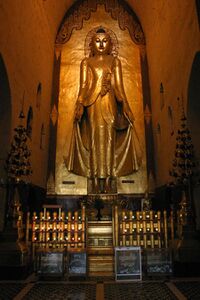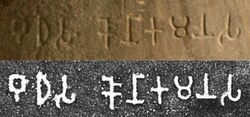Religion:Koṇāgamana Buddha
| Kanakamuni Buddha | |
|---|---|
 East-facing Konagamana Buddha, Ananda Temple, Myanmar | |
| Sanskrit | कनकमुनि Kanakamuni |
| Pāli | Koṇāgamana |
| Burmese | ကောဏာဂုံ [kɔ́nàɡòʊɰ̃] |
| Chinese | 拘那含佛 (Pinyin: Jūnàhán Fó) |
| Japanese | (romaji: Kunagonmuni Butsu) |
| Khmer | ព្រះពុទ្ធកោនាគមនោ Preah Puth Kaonakemeno |
| Korean | 구나함모니불 (RR: Gunahammoni Bul) |
| Mongolian script | Канагамуни |
| Sinhala | කෝණාගමන බුදුන් වහන්සේ |
| Thai | พระโกนาคมนพุทธเจ้า Phra Konakhamana Phutthachao |
| Tibetan | གསེར་ཐུབ་ Wylie: gser thub THL: Sertup |
| Vietnamese | Phật Câu Na Hàm Mâu Ni Phật Câu Na Hàm |
| Information | |
| Venerated by | Theravada, Mahayana, Vajrayana |

Koṇāgamana Buddha (Pāli), known as Kanakamuni in Sanskrit, also known as Koṇāgon or Kanakagamana, is one of the ancient Buddhas whose biography is chronicled in chapter 23[2] of the Buddhavamsa, one of the books of the Pāli Canon.
Buddhist tradition
According to Theravāda Buddhist tradition, Koṇāgamana is the twenty-sixth of the twenty-nine named Buddhas, the fifth of the Seven Buddhas of Antiquity, and the second of the five Buddhas of the present kalpa.[3]
The present kalpa is called the bhadrakalpa (Auspicious aeon). The five Buddhas of the present kalpa are:[4][5]
- Kakusandha (the first Buddha of the bhadrakalpa)
- Koṇāgamana (the second Buddha of the bhadrakalpa)
- Kassapa (the third Buddha of the bhadrakalpa)
- Gautama (the fourth and present Buddha of the bhadrakalpa)
- Maitreya (the fifth and future Buddha of the bhadrakalpa)
Koṇāgamana is said to have been born in Subhagavati Park in Sobhavati[2] (now known as Araurakot, located about 3 kilometres (1.9 mi) southwest of Nigalihawa) on Wednesday;[6] because of this Koṇāgamana is placed on the Wednesday pedestal.
Historical mentions of the Koṇāgamana Buddha
The Koṇāgamana Buddha is mentioned in a 3rd-century BCE inscription by Ashoka at Nigali Sagar, in today's Nepal. There is an Ashoka pillar at the site today. Ashoka's inscription in Brahmi is on the fragment of the pillar still partly buried in the ground. The inscription made when Emperor Asoka at Nigali Sagar in 249 BCE records his visit, the enlargement of a stupa dedicated to the Kanakamuni Buddha, and the erection of a pillar:
"Devanam piyena piyadasin lajina- chodasavasa bhisitena Budhasa Konakamanasa thube-dutyam vadhite Visativa sabhisitena –cha atana-agacha-mahiyite silathabe-cha usa papite"
“His Majesty King Priyadarsin in the 14th year of his reign enlarged for the second time the stupa of the Buddha Kanakamuni and in the 20th year of his reign, having come in person, paid reverence and set up a stone pillar”.[7][8]
According to Xuanzang, Koṇāgamana's relics were held in a stupa in Nigali Sagar, in what is now Kapilvastu District in southern Nepal.[9]
See also
- Bhadrakalpikasutra
Gallery
Nigali Sagar Pillar erected by King Ashoka to commemorate the birthplace of Koṇāgamana Buddha. Nigalihawa, Kapilvastu District, Nepal (inscription on the smaller fragment)
References
- ↑ John Marshall, A Guide to Sanchi, 1918 p.46ff (Public Domain text)
- ↑ 2.0 2.1 Vicittasarabivamsa, U (1992). "Chapter 23: Koṇāgamana Buddhavamsa". in Ko Lay, U; Tin Lwin, U. The great chronicle of Buddhas, Volume One, Part Two (1st ed.). Yangon, Myanmar: Ti=Ni Publishing Center. pp. 280–5. http://www.myanmarnet.net/nibbana/gotama/gcobv12.htm#23.
- ↑ Gärtner, Uta; Jens Lorenz (1994). Tradition and modernity in Myanmar. LIT Verlag. p. 281. ISBN 978-3-8258-2186-9.
- ↑ Buswell Jr., RE; Lopez Jr., DS (2014). The Princeton Dictionary of Buddhism (1st ed.). Princeton, New Jersey: Princeton University Press. pp. 106. ISBN 978-0-691-15786-3. https://books.google.com/books?id=DXN2AAAAQBAJ&q=Buddhas+of+the+present+kalpa&pg=PA106.
- ↑ "Chapter 36: The Buddhas in the three periods of time". Buddhism in a Nutshell Archives. Hong Kong: Buddhistdoor International. http://www.buddhistdoor.com/OldWeb/bdoor/archive/nutshell/teach36.htm.
- ↑ Reid, Robert; Michael Grosberg (2005). Myanmar (Burma). Lonely Planet. p. 93. ISBN 978-1-74059-695-4.
- ↑ Basanta Bidari - 2004 Kapilavastu: the world of Siddhartha - Page 87
- ↑ (in sa) Inscriptions of Asoka. New Edition by E. Hultzsch. 1925. p. 165. https://archive.org/stream/InscriptionsOfAsoka.NewEditionByE.Hultzsch/HultzschCorpusAsokaSearchable#page/n339.
- ↑ John S. Strong (2007). Relics of the Buddha. p. 130. ISBN 978-0691117645. https://books.google.com/books?id=_KLAxmR8PZAC.
| Preceded by Kakusandha Buddha |
Seven Buddhas of the Past | Succeeded by Kassapa Buddha |







